By Nathan Humpal, Metadata Librarian
A curious thing has been happening while playing The Witness on “The Cat’s Moustache.” As the game progresses I find my puzzle-solving becoming more and more tactile. The Witness’ early puzzles are deceptively simple, as it appears that you will be solving relatively straightforward mazes. But the game quickly introduces numerous wrinkles: You’ll need to hit certain points within the maze or use clues in the environment to navigate it. All these complications are not spelled out for you but are introduced in a way that helps you intuit the rules, before complicating them with further barriers to completion.
But solving these puzzles in the digital realm can be cumbersome or, I would argue, nearly impossible at times. A digital game doesn’t allow the freedom of movement that a piece of paper might, nor does it give you all of the resources to work things out. White space to take notes, alternative angles, or other physical resources aren’t provided. As a result, I’ve taken to using a scratch pad to work out certain puzzles. The most extreme of these has been a series of puzzles that require you to create a shape by placing blocks on a grid. When doing these, I cut out the shapes and placed them on a mock grid to figure out the solution. I have no idea if the creators of the game envisioned such a solution, but I can’t possibly imagine doing those puzzles without such an aide.
Using analog resources is, of course, nothing new in digital games. Early computer role playing games (such as 1985’s The Bard’s Tale, currently being played on Classic Quests) highly recommended the use of maps to navigate dungeons. Even a simple manual can be construed as an analog resource if the directions it gives you are not explained in game. Of course, these things become less and less likely as games grew more complicated and began including in-game maps and using explicit tutorials.
Perhaps because of this, it took me longer to return to an analog crutch during The Witness. It was somewhat exhilarating to say, “Wait a minute I’m going to need to write this down,” while working through a puzzle. I mentioned earlier that I was unsure if the creators intended this. That hardly matters regarding the efficacy of them, but it does make me wonder if it’s some sort of cheat. Or, perhaps a better question would be: what resource outside of what a digital game provides could be considered a cheat?
You can watch Nathan and Josh Rivers’ progress through The Witness on The Cat’s Moustache.
Watch The Cat’s Moustache: The Talos Principle from Serious_Play on www.twitch.tv

The idea of the cheating is an interesting one. We started talking about this a bit in The Lunch Zone on 3rd when we played our first comic book game, Comix Zone, which was old school (1995). Now, as it as been fitted for the PC it has added features like “rewind” which you (Nathan) used frequently, and called it an overuse of the new tool and even called it cheating. Here, in this post, you use the word “crutch.” I wonder if it is a crutch or not, or if its just ingenuity, going back to a reliable tool to help you solve the puzzles? Not only does it help you solve the puzzles, but it also allows us, the audience, to see and understand how you arrived at the final answer (which from my understanding is the purpose of The Cat’s Mustache).
I am wondering if we can explore the concept of cheating a bit further here?
-Laya Liebeseller @Playscholar
If a player has eidetic memory and can visualize and rearrange the puzzle in their head without the use of physical blocks, would that be considered cheating? The use of analog tiles doesn’t provide you with outside information, it simply allows you to visualize the available information differently. To claim that this is cheating would mean that the rules of the game dictate HOW you’re allowed to think about the game, which is absurd.